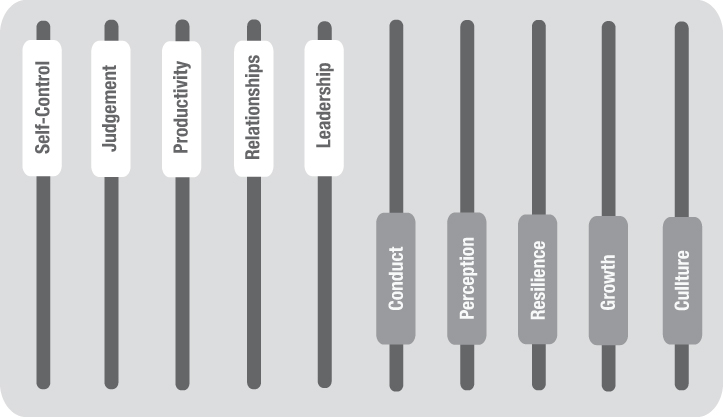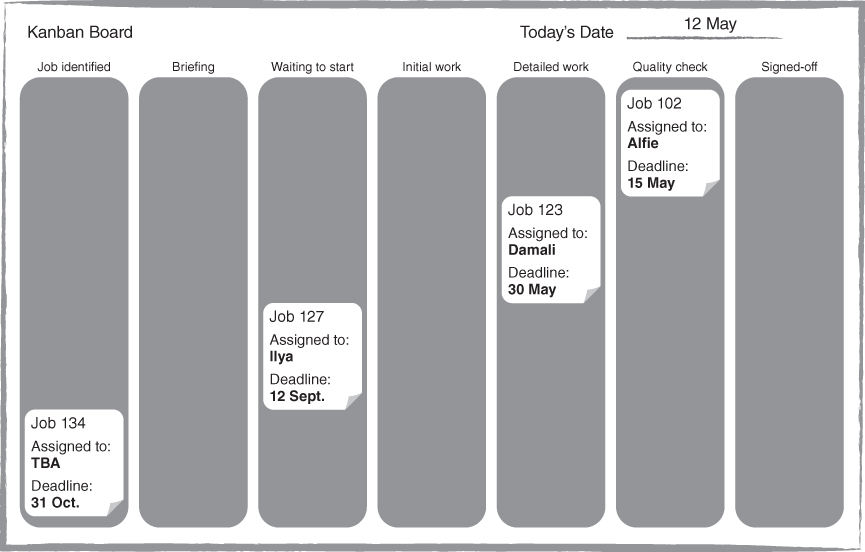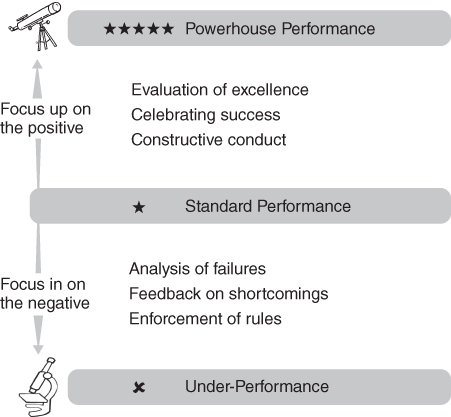Chapter 5
Leadership
Get the Best From the People Around You

The true Powerhouse does not work alone. Having built relationships to support your work, you will also need to focus on immediate team members and colleagues who you can call on for practical assistance. How will you allocate work among them, secure guidance and support, and ensure people collaborate well and take responsibility for their portion of work? This chapter is about leadership, so I will also show you how to secure cooperation and ensure that people meet their commitments to you with their own Powerhouse capabilities.
Deploying Your Troops
Powerhouse effectiveness comes most readily when we play to our strengths.
The fundamentals of managing and leading people are in giving each person the right role to play and the resources that they need to do it well. A Powerhouse knows that this does not happen by chance. Instead, you need to make careful decisions about how to assign work, you need to hand over the work properly, and you need to be able to monitor progress in a way that is transparent to everyone.
Assigning
When we do work we enjoy and work that we are good at, that work feels effortless. As we do it, we feel in control, we are aware of our progress and we have a calm, focused state of mind. Powerhouse effectiveness comes most readily when we play to our strengths; so when you assign work to other people, if you can, assign the work that they are drawn to.
A Powerhouse also knows that fairness is important to people. We worry less about what we are being asked to do and the rewards we are getting than we do about the person next to us. We want to know what our colleagues are up to. If we do, this makes it easier to collaborate, so make sure you communicate who is assigned to what work. When you give work to someone you have the opportunity to set them up to succeed, or possibly to fail.
There are five essential steps to a Powerhouse briefing, which you can remember easily as CODAC: Context, Outcome, Deadline, Authority and Commitment.
1. Context
Setting the context for the job serves several important functions, yet it is often something people miss out when briefing staff. It feels like irrelevant background so, when time is tight, it gets squeezed. However, context is vital. First, it gives the answer to the question why, and without that answer we tend not to be motivated. Second, taking the time to give some of the context shows trust and respect. Giving context will allow the other person to inject their own ideas and insights into their work. Finally, you don't want your own work constantly interrupted by a stream of unnecessary questions. The more thoroughly you brief at the outset, the less this will happen, and by giving a lot of background, people are better equipped to interpret the unexpected and make their own decisions.
2. Outcome
Think of this as your definition of success. If you are tasking me with a job, I will want to get good results – that's what will make me feel good about myself. So tell me what I need to aim for and how you will assess my work. The key Powerhouse concept here is of a Success Template: a specific set of things I need to achieve to make you entirely satisfied with my work. Once I have that, I can use it as my guide in what I am doing.
3. Deadline
Deadlines are vital so I can schedule my work effectively. For some people, the pressure of a deadline is also motivating.
4. Authority
If you ask me to do something, be clear with me how much authority you are giving me. This is at the heart of managing the risk of giving work to someone else, so if you have a high level of confidence that I will deliver, and the consequences of mistakes are constrained, then give me full authority. If, however, there are important consequences of errors and you don't have full confidence in my abilities, then make sure I can only take limited steps without checking back with you.
The three Rs of authority are: Rules, Resources and Reporting.
- Rules: are there procedures, process, or steps I must follow? If so, let me know.
- Resources: what resources can I access and is there an overall budget I must adhere to?
- Reports: what reports do you need me to make?
5. Commitment
If it is a common mistake that managers skimp on the context, it is far more common and far, far more dangerous when they fail to secure a firm commitment from the person to whom they are delegating work. I guess that, once they have briefed, some managers just don't want to break the spell. They would rather just assume that all is well and leave it as an assumption that the other person will do as they are asked.
Always make sure that:
-
Your instructions have been understood. ‘What other questions do you have?’ ‘Are you completely clear about what I need?'
-
The other person feels able to do the work. ‘Are you able to do this piece of work?'
-
The other person is committed to doing the work. ‘Will you do this piece of work, by the date I set?'
Always treat any answer that is ambiguous or tentative as a ‘no' and explore further. In return for this commitment, give your own commitment to provide the support and guidance that the other person needs.
Tracking
We need to see progress when we are working on something, because progress makes us feel good and seeing it gives us a sense that we are in control. You too need this information, to feel confident that the person working for you is on track. A Powerhouse loves progress.
The Japanese system of Kanban cards, used in just-in-time processing, provides a very simple and elegant way to display the progress of a range of jobs. To use it, you need to define generic stages that apply to the jobs. It doesn't matter if some jobs will not go through every stage, but it is important that each stage a job will go through is represented by one of your generic stages. Let's say the stages we want to use are: job identified, briefing, waiting to start, initial work, detailed work, quality check and signed off. Using these, we create a Kanban board – usually a chalkboard, a pin-board or a whiteboard, with these stages as seven columns. Now each new job gets its own Kanban card – a magnetic or sticky note, or a card, that can be placed onto the board. On each card write the name of the job, the deadline and the person to whom overall responsibility is assigned. Now place each card in the right column, as illustrated.

Kanban board
Winning Support
You get the team you deserve.
When you are planning work, the first task is to decide what you want to achieve, and why. Then you need to decide how you are going to do it. After that, you will think about how many people you require to help, what kind of people they should be, and what skills they will need. We have looked at all of this. Now you need to win their support by motivating them to deliver the Powerhouse performance you want.
You get the team you deserve. Not because the universe is fair: it isn't. But because if you work hard to engage, support and motivate your team, they will work hard to deliver the performance you want. If you don't do your bit: they won't do theirs.
Motivating Your Team
What motivates you? Almost certainly, it is lots of things. First, there are things like being safe, feeling secure, having a home and putting food on your table. These are the basic motivators that any job will address.
Then there are the things that lots of people think of, when asked this question: money, pleasures, rewards, toys, goods, holidays … These are the things that feel motivating. But, strangely, once we have a certain amount, having more of them makes very little real difference to our lives. We seem to know this instinctively, because their impact on our personal effectiveness, beyond showing up and doing what our contract says, is minimal most of the time. The exception is when you set your mind on one particular reward.
Powerhouse performance – from you and from the people you lead – comes from the small, subtle difference that four other motivators make. If you want to create Powerhouse performance, you need to give an extra GRAM of motivation.
GRAM stands for the four big motivators for Powerhouse performance:
- Growth.
- Relationships.
- Autonomy.
- Meaning.
1. Growth
We all need to feel that we are developing in our skills and knowledge and becoming more expert at the work we do. This is linked to our fundamental need for achievement, so you can motivate yourself and others by understanding the directions that each of us needs to grow in, and creating the opportunities to make real progress.
2. Relationships
For those who work full time, we spend more of our time awake with our work colleagues than we do with the people we deliberately choose to spend our lives with; partners and family. So good relationships at work are vital to our wellbeing. Some of us have a particularly strong need to be a part of a group, a family or a team. Attend to this by making team coherence a priority and building an environment of mutual care and support. You will always achieve more when you are prepared to forego the personal credit and rewards, and pass them on to the team of people who help you.
3. Autonomy
Relationships are important, but so is our need to feel in control of our lives and responsible for our own choices. For each of us, the balance between the needs for membership of groups and individual autonomy is different. You need to get to know the individuals who work for you, to find out where the right balance is for each of them. In some, this need for autonomy can manifest as a desire for authority and even power over others too.
4. Meaning
We all need to feel we have a purpose and we want that purpose to be worthwhile. Motivate by sharing the reasons for what your team are doing and strengthen it by giving each person the confidence that there is a plan that will achieve that purpose. People with the strongest need for autonomy, however, can easily find too much of a plan frustrating: it constrains their ability to feel in control of their lives. For them, provide an outline plan, focusing on middle and longer-term outcomes and leaving them more freedom to figure out how. For others, they will require greater certainty about the way they can achieve their outcome, so provide more detailed plans.
Communication is the Glue
What is it that holds a team together, mediates relationships and articulates meaning? A team is nothing unless communication works well at all levels: from the leader to team members, from the team members to their leader, and among team members. Teams need to share stories, resolve conflicts, solve problems and make decisions. All of these require that different people, with different knowledge and perceptions, are able to communicate effectively with one another.
The most fundamental Powerhouse communication skill is listening. Powerhouse listening means:
Focus on the other person and what they are saying:
-
Don't judge what they say – just listen.
-
Don't look for the next conversation – just listen.
-
Don't try and figure out what to say next – just listen.
If you can train yourself to just listen, the quality of your understanding will improve, the quality of your questions will improve, and the quality of your relationships will improve.
The Psychology of Success
The leap from standard performance to Powerhouse performance is greater than the leap from under-performance to standard performance.
There is a new and exciting field of research that has grown up over the last 15 to 20 years, which is studying and learning from Powerhouse organizations that are really thriving. It is turning the lessons from these organizations into prescriptions for how to help your people and your organization flourish too. It is called Positive Organizational Psychology.
The transition from under-performance to standard performance often comes from a focus on three things: analysis of failures, feedback on shortcomings and enforcement of rules.
None of these, however, will leap your team to Powerhouse performance – which is arguably a greater leap than that from under-performance to standard performance. For that great leap, we need three new approaches to replace the more familiar list above: evaluation of excellence, celebrating success and constructive conduct.
Evaluate Excellence
A common managerial approach is to try to get to the root of failure, to dig it out and find alternative solutions. This works well when failure is the prevailing culture, but does not support good performers in achieving excellence. Instead, you need to focus on examples of excellence – the things that make a real positive difference – and understand them. Get your team together to learn from one another and encourage people to share success stories. Resilient salespeople understand that if they do not win, they need to learn from the experience. A Powerhouse knows that if they do win, they can learn from that experience.

The leap to Powerhouse performance
Celebrate Success
Feedback on shortcomings often takes the form of criticism: ‘you did well, but …’ For a Powerhouse performance:
cut the but.
Instead of a critical eye, learn to look for and celebrate examples of great performance. This works best when you do it often, as soon as you notice the valuable behaviours, and in a way that has meaning to the person whose great work you are noticing.
A fabulous resource is Diamond Feedback. Think of the four suits in a pack of playing cards:
- Clubs are for beating people up with.
- Spades are for digging down and finding out what went wrong, and why.
- Hearts are lovely, we use them to give unqualified, unspecific praise.
- Diamonds are valuable – use diamond feedback to focus on what I did and why it is valuable to you.
Behave Beneficially
It is easy to get into the habit of following the rules and treating your team members fairly. And this is good. For Powerhouse performance, though, you need to go further and treat people well. Do things wantonly that benefit the people around you, like offering gratitude, compliments and support. A few random acts of kindness to your team each week will have a huge impact on their performance.
One of the main things you can focus on is the relative frequency with which you respond positively to the things the people around you do or say. We often get into a mind-set of criticism, challenge and denial. To get the best out of people, aim to say three or more times as many positive things as you do negative things, throughout the day, in meetings and when working one-to-one with colleagues.
Securing Compliance and Completion
The Jiminy Cricket effect is the way our conscience holds us to account.
Have you ever asked someone to do something and, a week later, they have not done it? Of course you have. What went wrong? The answer is often very simple: Jiminy Cricket was asleep on the job. Jiminy Cricket acts as Pinocchio's conscience. You and I have a Jiminy Cricket organ in our heads and, except in the few people out there with little integrity, it does a great job at reminding us to do what we promise … as long as it was not asleep when we made the promise.
If you bump into a colleague, Jenny, in the corridor and ask for a favour, how often do you make a big deal of it? Probably, rarely. You don't want to because you don't want to draw attention to the fact that it is a favour and you feel uncomfortable asking for it.
So, when Jenny mumbles ‘yeah, okay, leave it with me' you are delighted and move on quickly, before she changes her mind. The problem is: she wasn't paying a great deal of attention and so, when she mumbled her agreement, it wasn't a formal promise; she was just conforming to social convention.
Instead, you need to look Jenny in the eye and say: ‘Have you got a moment?’ and wait for her to respond.
When Jenny says ‘yes', Jiminy is awake. If she says ‘no', then she wouldn't have been able to commit properly anyway – so find out when she is free to talk.
Once you have Jenny's and Jiminy's full attention, you can ask for the favour. Now get a promise that Jiminy can enforce. Look Jenny in the eyes again and ask: ‘Will you do that by Friday afternoon?’ The deadline is important.
If she says yes clearly and confidently, then Jiminy will be on the job. Remind Jenny on Friday morning and, if she has not done it, her conscience will be pricked and Jiminy will be working hard to get it done.
If Jenny says no, then it is better to know that now, than to find out on Friday afternoon when she hasn't done it.
You can even test the strength of Jenny's promise. Ask what would get in the way of fulfilling it. If the answer is a solid reason why something specific could get in the way, then chances are that there is real concern to deliver on the promise. On the other hand, a lame reason like ‘things might crop up' suggests instead that she is looking for excuses to not deliver.
Once you get a promise, acknowledge it by saying something like: ‘Thank you for that commitment – it is important to me.’ By adding the importance, of course, you are raising the stakes for her compliance.
Finally, don't feel shy about sending repeated reminders. Research by Paul Leonardi, Tsedal Neeley and Elizabeth Gerber found that managers who reminded team members about their assigned tasks multiple times and in different ways had considerably more success in gaining task completion on time.
So, to summarize:
- Alert Jiminy Cricket that you are looking for a promise.
- Set a deadline to trigger Jiminy.
- Confirm that I have made a promise.
- Tell me my promise is important.
- Check the level of my commitment to my promise.
- Remind me a few times along the way.
Leadership: 8 Powerhouse Pointers
- Powerhouse effectiveness comes most readily when we play to our strengths.
- Remember the five essential steps to a Powerhouse briefing as CODAC: Context, Outcome, Deadline, Authority and Commitment.
- You get the team you deserve. Motivate your team through by using GRAM: Growth, Relationships, Autonomy and Meaning.
- Communication is the glue that holds a team together.
- The leap from a standard performance to a Powerhouse performance is greater than the leap from under-performance to standard performance.
- For a Powerhouse performance: cut the but.
- A few random acts of kindness to your team each week will have a huge impact on their performance.
- The Jiminy Cricket effect is the way our conscience holds us to account.
